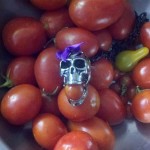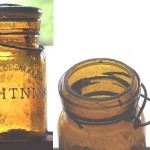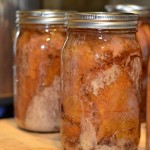If you have a garden you are probably up to your ears in fresh produce. As tomatoes and green beans pile up on your counter, you can’t help but ask yourself, “What do I do with all of it?” You turn to your freezer and slide away the frozen pizzas and meat and realize you won’t be able to fit it all in there. Now what? You could give some away to your neighbors, kids, leave some on the corner with a “Free” sign on it.
What if there was a way to preserve your food that doesn’t require refrigeration or  freezing or even stray boxes on the corner. Why not try canning? Canning is an age old way of preserving food to make it shelf safe for years to come. It’s also a great way to have a home cooked meal when pressed for time. You probably remember your grandma’s jam or her root cellar filled with dusty old jars filled with vegetables and fruit. In years past, canning was a common way to preserve food so there would be enough to last for the winter.
freezing or even stray boxes on the corner. Why not try canning? Canning is an age old way of preserving food to make it shelf safe for years to come. It’s also a great way to have a home cooked meal when pressed for time. You probably remember your grandma’s jam or her root cellar filled with dusty old jars filled with vegetables and fruit. In years past, canning was a common way to preserve food so there would be enough to last for the winter.
Canning dates back to the late 18th century in France when Napoleon Bonaparte offered  a cash prize to anyone who could come up with a reliable way to preserve food so he could keep his armies fed. After 15 years of experimentation, a man by the name of Nicholas Appert realized that if food was heated enough and sealed in an airtight container, it could be preserved. A little while later, Peter Durand took it one step further and used this idea to develop a way to seal food in tin cans. These processes were perfected by Bryan Dorkin and John Hall who set up the first commercial canning factory in 1813. The first canning factory in the US was developed in New York in 1812 by Thomas Kensett. This factory canned oysters, meat, fruit and vegetables. It wasn’t until 50 years later that the process could be explained as to why it worked, Louis Pasteur demonstrated that the growth of microorganisms is the cause of food spoilage.
a cash prize to anyone who could come up with a reliable way to preserve food so he could keep his armies fed. After 15 years of experimentation, a man by the name of Nicholas Appert realized that if food was heated enough and sealed in an airtight container, it could be preserved. A little while later, Peter Durand took it one step further and used this idea to develop a way to seal food in tin cans. These processes were perfected by Bryan Dorkin and John Hall who set up the first commercial canning factory in 1813. The first canning factory in the US was developed in New York in 1812 by Thomas Kensett. This factory canned oysters, meat, fruit and vegetables. It wasn’t until 50 years later that the process could be explained as to why it worked, Louis Pasteur demonstrated that the growth of microorganisms is the cause of food spoilage.
During the 19th century, wire-clamped jars such as Lightning and Atlas jars were used up until 1964. In 1858, John Mason developed a glass container with screw on threads and a lid with a rubber seal. These are the jars that we still use today to preserve our food. Well, that and moonshine – but that is a story for another day. Also, around this  same time, William Charles Ball also developed their own version of the “Mason” jar, which is why “Ball” jars are just as popular as “Mason” jars for canning. These jars had narrow openings, or “regular mouth” jars, it wasn’t until 1915, when Alexander Kerr invented the wide mouth jars, which made filling the jars easier. Alexander also developed the metal lid with the permanent rubber gasket and metal ring we are so familiar with today. Ball quickly duplicated this method and hence, the modern era of canning was born.
same time, William Charles Ball also developed their own version of the “Mason” jar, which is why “Ball” jars are just as popular as “Mason” jars for canning. These jars had narrow openings, or “regular mouth” jars, it wasn’t until 1915, when Alexander Kerr invented the wide mouth jars, which made filling the jars easier. Alexander also developed the metal lid with the permanent rubber gasket and metal ring we are so familiar with today. Ball quickly duplicated this method and hence, the modern era of canning was born.
While the tools used for canning have improved greatly over the years, the basics of canning have not changed since the 1800’s. Heat the food sufficiently and destroy all the “nasties” that will make you sick and seal it in an airtight container so they can’t grow. Then you process the sealed jars using pressure or boiling them in water. The amount of time varies depending on what you have in your jars, as does the process of applying heat.
I really enjoy canning food. I guess I should clarify that canning means putting food in jars and not actual cans. Some people turn their nose up at canning because of how  commercially processed canned food tastes, but I assure you – home canned food tastes delicious. The meats and vegetables maintain their flavor and in the case of meats, it is improved. My corned beef is really delicious out of the jar.
commercially processed canned food tastes, but I assure you – home canned food tastes delicious. The meats and vegetables maintain their flavor and in the case of meats, it is improved. My corned beef is really delicious out of the jar.
Make a batch of jelly or can up some pickles, they make great gifts and your friends and family will thank you for them!


